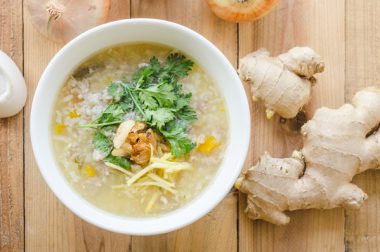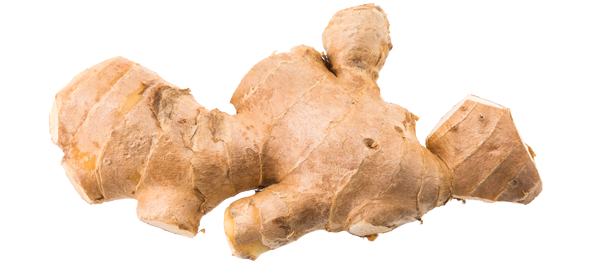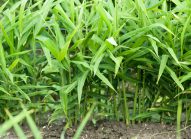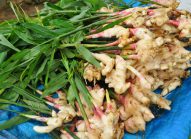Recipes we love
See all recipesBananas with ginger
Serve this dessert on a bed of fromage frais to give you one of the 3 portions of calcium you need e...
Sea bream tartare with ginger
An excellent source of protein, raw fish will provide you with precious vitamins, such as Vitamin D,...
Health
benefits
A great boost!
Ginger contains phytochemical compounds that are known for their stimulating properties that act on several of the body’s physiological functions (appetite, digestion, and even sexual function!).
It also contains:
- manganese
- copper
Ginger, both fresh and dry, is eaten in small quantities, so nutritional benefits are not significant.
Ginger is also:
- a source of potassium (for the nervous system, muscular function, and blood pressure)
- a source of magnesium (for fatigue reduction, energy, protein synthesis, muscular contraction, nerve impulse transmission, and bone and teeth health)
Nutritional
composition
When is the right
time to eat it?
All year.
Ginger is available year-round in different forms (fresh, powdered, and candied).
Vegetable patch or
urban balcony?
Ginger is an herbaceous perennial that grows well in well-drained, light, neutral (pH = 7) soil rich in humus, in sunny spots.
To learn everything you need to know about growing ginger, read the page on growing advice.
Choosing and
storing ginger
Choose your ginger well:
- The rhizome should be firm and should not be moldy. Its flesh should be pale, juicy, and very fragrant.
Properly store your ginger:
- In the refrigerator: Two to three weeks.
- In the freezer: take it out when needed and grate while it is still frozen.
- In a sugar or maple syrup: this is an Asian-style preparation.
- Dried: in a cool area away from light, in a sealed container.
Tips and
tricks
How to prepare ginger
- Grated or chopped fresh: Ginger can be used in stir fries, curries, and fish dishes.
- Pickled: it is indispensable in Japanese cuisine, including with sushi, sashimi, and tempura.
- Candied: it can be used in cakes.
- Dried and ground: it is one of the spices used in spice bread.
Did you know? Cooking heightens the spicy taste of ginger. Add it after cooking, right before serving the dish.
Different uses of ginger in the world:
In Thailand, people add ginger to their curry paste, and in Indonesia, they add it to fresh spice pastes that are spread on meat before it is cooked. There is a fizzy, non-alcoholic ginger beverage called ginger ale that is very popular in the United States and Canada, which contains ginger extract and, like root beer, is a non-fermented and sugary beverage.
Tip for peeling ginger: Use the inside of a soup spoon rather than a peeler, using the base of the spoon to get into the root’s nooks. The skin will come off easily, with less ginger wasted than with a peeler.
Ginger goes well with…
It has an exceptional flavor, giving a delicious flavor reminiscent of Asian cuisine to any dish.
Raw: It lends its exotic flavor to salads (with beets, cucumbers, etc.) and sauces (mayonnaise and more).
Cooked: It goes especially well with honey, sugar and dark chocolate in sweet recipes, and with vinegar and garlic in savory ones. It gives character to fish and white meat dishes and flavors broths and desserts.
Can everyone
eat it?
Young children
Children do not like the very strong flavor and the burning compounds in ginger. Give them small quantities to test their ability to digest and appreciate the food when they turn six.
And everyone else
Watch out for the burning compounds that it contains that can exacerbate a stomach sensitive to heartburn or a sensitive bowel. However, paradoxically, it also facilitates digestion and prevents nausea and vomiting in people susceptible to sea sickness and in pregnant women.
See plenty of other tips for encouraging children to eat vegetables

Where does it come from?
Origins and varieties
Origins: Native to Southern India and China (the top two producers), where it is used as a condiment and in medicine, ginger was brought to Europe by Arab traders around 100 BCE. Brazil, Jamaica, and Nigeria are the other main producers of ginger in the world.
Varieties: Each climate results in the production of a unique rhizome.
- Jamaican ginger is known for its delicate scent and is eaten fresh.
- African ginger (from Nigeria and Sierra Leone) is more full-bodied, with a strong camphor flavor. It is used to produce essential oils and oleoresin.
- Indian ginger has a lemony flavor and is produced as an export. It is often sold dried.
- Chinese ginger is produced in large quantities, but because it is treated with sulfur dioxide, it is banned in Europe. Only unprocessed ginger may be imported.



 Bitter greens
Bitter greens  Endives
Endives  Vegetable garden: growing cardoon
Vegetable garden: growing cardoon 











